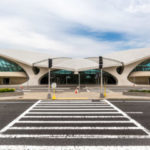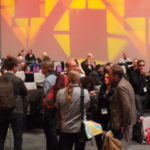From 2008 through 2010, when the auto industry was under heavy scrutiny and in the throes of near-collapse, the easy thing to do, according to Rod Alberts, the executive director of both the Detroit Auto Dealers Association (DADA) and DADA’s annual North American International Auto Show (NAIAS), would have been to pump the brakes.
Instead, NAIAS hit the gas. When manufacturers pulled out and there was empty space to fill, show organizers created a new showcase dedicated to the growing trend of electric-vehicle technology. To keep high-end manufacturers from leaving in droves, they created The Gallery — a VIP, invitation-only event at the MGM Grand Detroit that let customers get up close with the world’s most luxurious cars. And in the middle of all that, Cobo Center — where NAIAS has called home since it began 25 years ago — came under the new management of the Detroit Regional Convention Facility Authority and SMG.
It was another challenge. And another opportunity.
Under The Hood
NAIAS isn’t just your typical show. It’s actually five events in one, held over a 14-day period — including an industry preview, a media preview, a single-night Charity Preview, public days, and The Gallery event. The press preview takes place first, with more than 5,000 journalists from 58 countries attending this year, followed by the industry preview, when 23,000 automotive professionals from 2,000 companies file in over the course of two days to see the industry’s latest and greatest. The Charity Preview, held the evening before the public show begins, is the largest single-night fundraiser in the world, and has raised more than $87 million for southeastern Michigan children’s charities since it began in 1976. The public show lasts nine days, drawing nearly 800,000 people to view the 500 vehicles on display by nearly every major automobile manufacturer in the world.
The Gallery is the newest addition to the lineup, and has been successful not just because it was born out of necessity, but because it’s had staying power beyond the economic downturn. Charging guests $500 a ticket and capping attendance at just 500, The Gallery gives its well-qualified customers an exclusive preview of the world’s uber-luxury automakers” along with a dinner catered by Wolfgang Puck and a fashion show.
“Our thought was, to keep those kind of cars in our show, let’s have a special, off-site event, spend money on it even though we don’t have sponsors, hold it at a high-end hotel, invite American Express Black Card members, and bring the customer to the brand and the manufacturer,” Alberts said. “The beauty of [the idea is] that you start partnering with more people and you create a dimension in your show that no one else has. This was done during our downturn, because we didn’t want to lose the Lamborghinis and Ferraris from our show, and this was a way of keeping them involved, and when things get better, they’re back in your other show, too, so now you have them in two shows.”
Another challenge during the downturn: When manufacturers dropped out and swaths of the show floor were left vacant, Alberts and his team had to think on their feet and get creative about what to do with the empty space. Recognizing the growing trend of electric cars, in 2010 NAIAS launched a new attraction — the 37,000-squarefoot Electric Avenue. The showcase not only spotlighted the growing trend of electric vehicles and related technology, it featured a landscaped ride-and-drive track where visitors could test out vehicles in a unique, conversation-starting green space.
“The key was not to just put up cones and [let visitors] drive around them,” Alberts said. “We put in an entire 80,000-square-foot landscape with trees, mulch, and grass, and we actually tricked the foliage and flowers to bloom in January by putting them in a warm environment.”
Electric Avenue not only helped fill space and avoid the perception of an empty show floor, but also became a talking point for the media and public. “It’s not about just bringing the cars,” Alberts said, “it’s about offering something that everyone can go home and talk about, whether it’s media or suppliers or anyone else in the industry.”
Both projects required large investments — creatively and financially. And launching them during a downturn was far from a sure thing. “If you’re going to do something, you have to go all out,” Alberts said. “If you want to stay ahead of the game, you have to be willing to step out there and make those calculated risks to bring it all together. Even though we’ve had the turnaround, those two elements are still part of the show. It was needed anyway, but the key is, it was prompted by the downturn.”
‘Everything Has Come Back’
At the same time, the show’s venue, Cobo Center, was also going through big changes of its own, which became another key element to the show’s recovery. In October 2010, SMG and Centerplate took over management of the facility’s operations; the year before, the center completed the first part of a three-phase, $300-million renovation and expansion that’s due for completion in 2015.
The project is seeking to drastically change Cobo’s size, scope, and perception. Some of those changes were already visible at NAIAS 2013, held on Jan. 14–27, which Convene attended as a guest of the Detroit Metro Convention & Visitors Bureau. One of the biggest centerpieces of the expansion — a dramatic staircase entrance that opens onto a 30,000-square-foot, riverfront atrium space — opened early for NAIAS 2013 to host a concert by Uncle Kracker at the Charity Preview event.
“I knew that there would be better times,” said Alberts. “The economy had to turn, we had new, better decisions being made in Cobo Center, and as long as we did what we had to do for the part that we controlled and managed, which is creating a great show, we knew we’d have a good home for it and we knew we had good management in the building to help guide what we were doing.”
The risks were worth it. This year’s Charity Preview event nearly sold out, with more than 13,000 guests in attendance and $4 million in proceeds raised. That’s a 30-percent increase from 2012 and an even bigger increase compared to four years ago, when the event raised $1.5 million. Overall, NAIAS 2013 did just as well — in total, 795,416 people attended, the show’s best numbers in eight years. “Everything has come back,” Alberts said, “but it’s better than it would have been because we invested during the downturn.”
Looking down the road, Alberts is interested in making NAIAS one of the most forward-thinking shows in the industry. Specifically, DADA leadership has begun talking with Chinese auto manufacturers about partnerships — a first for a North American auto show, Alberts said. And for the first time at this year’s show, NAIAS and the China Council for the Promotion of International Trade, which organizes the Beijing International Automobile Exhibition, hosted the Chinese Global Automotive Forum.
“I think we have to realize what an [important] market that is and embrace that,” Alberts said. “We are a worldwide, international event, and we want to have them involved, because it’s about displaying the latest product technology and cars from a worldwide industry.”.
Setting It All Up
The move-in and move-out of a show is always a cumbersome, time-consuming phase, but for NAIAS, it’s practically an event in itself. Thom Connors, regional vice president for SMG and general manager of Cobo Center, said that the first exhibitors — GM and Ford — begin moving in the first week of November, and the process continues through the opening of the show in mid-January.
To accommodate other business during this period, Cobo Center slowly fills up its more than 800,000 square feet of meeting and exhibit space with NAIAS’s almost outlandishly over-the-top showrooms, which can include everything from two-story vehicle displays to hospitality suites, offices, and built-in kitchens. And don’t forget the lighting — what’s a car show without a perfectly lit staging area?
“[NAIAS] has more rigging of lights and displays than any other show I’ve seen,” said Connors, who has worked for SMG since 1982. “The challenge is, sometimes there are as many as one thousand lighting instruments per display. Fortunately, Cobo Center was built with the infrastructure to accommodate this, with a 10-foot-by-10-foot rigging grid in the ceiling.”
Another aspect of what makes accommodating NAIAS such a feat — besides its plethora of 50,000-square-foot showrooms and numerous fleets of vehicles — is the fact that the show is really five shows in one, with the same spaces being re-used and re-vamped for most of the events, sometimes in the span of just one evening. “There’s a constant changing of displays and presentations throughout that week,” Connors said. “Overnight, between the Charity Preview and the first day of the public show, the ballroom becomes a food court, and the 30,000-square-foot media center converts into a beer garden.”



